DATSUN PICK-UP 1977 Service Manual
Manufacturer: DATSUN, Model Year: 1977, Model line: PICK-UP, Model: DATSUN PICK-UP 1977Pages: 537, PDF Size: 35.48 MB
Page 371 of 537
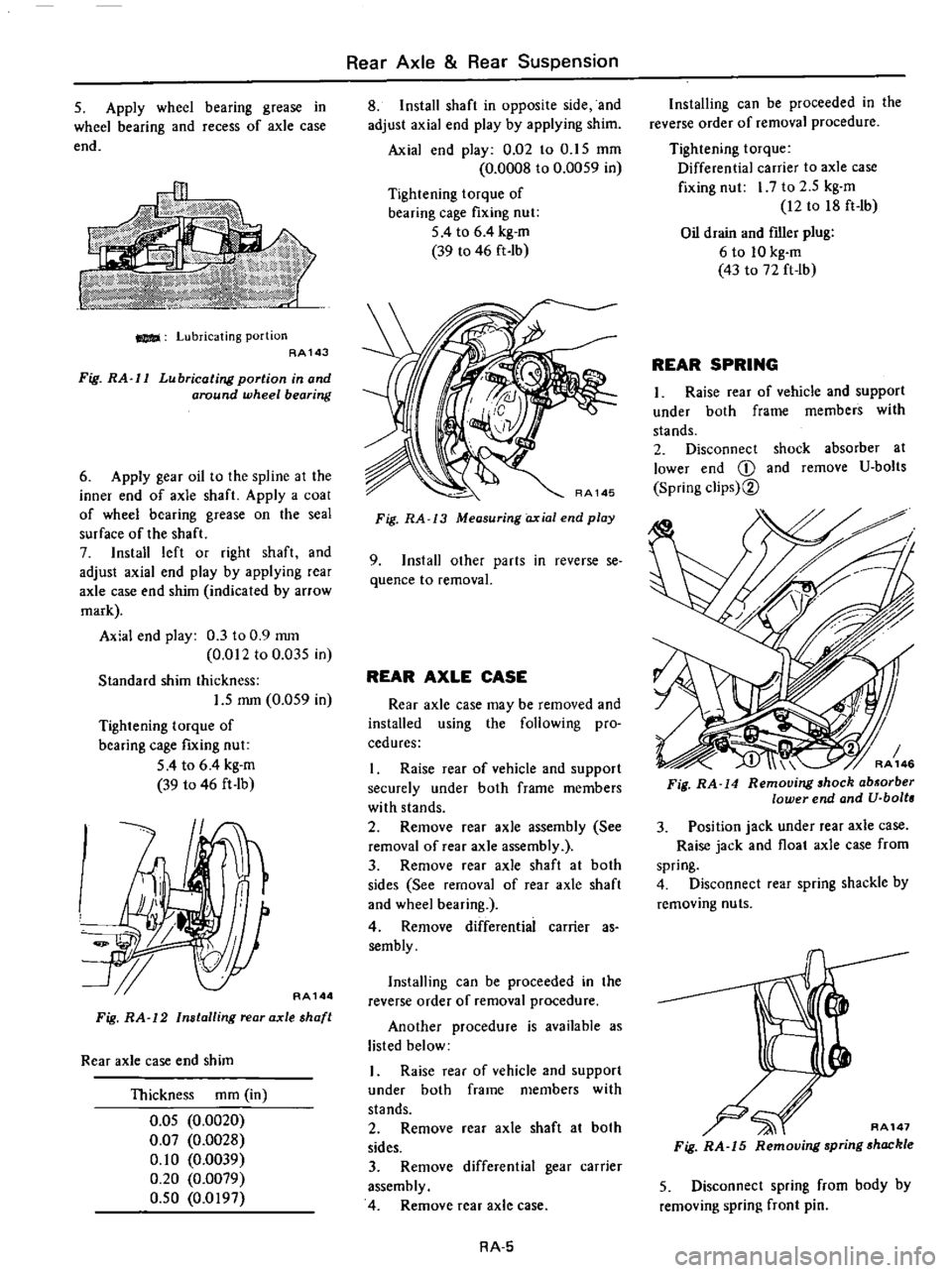
S
Apply
wheel
bearing
grease
in
wheel
bearing
and
recess
of
axle
case
end
Lubricating
portion
AA143
Fig
RA
l1
Lubricating
portion
in
and
around
wheel
bearing
6
Apply
gear
oil
to
the
spline
at
the
inner
end
of
axle
shaft
Apply
a
coal
of
wheel
bearing
grease
on
the
seal
surface
of
the
shaft
7
Install
left
or
right
shaft
and
adjust
axial
end
play
by
applying
rear
axle
case
end
shim
indicated
by
arrow
mark
Axial
end
play
0
3
to
0
9
mOl
0
012
to
0
035
in
Standard
shim
thickness
1
5
mm
0
059
in
Tightening
torque
of
bearing
cage
fIXing
nut
54
to
6
4
kg
m
39
to
46
ft
lb
w
AA144
Fig
RA
12
Installing
rear
axle
shaft
Rear
axle
case
end
shim
Thickness
mOl
in
O
OS
0
0020
0
07
0
0028
0
10
0
0039
0
20
0
0079
O
SO
0
0197
Rear
Axle
Rear
Suspension
8
Install
shaft
in
opposite
side
and
adjust
axial
end
play
by
applying
shim
Axial
end
play
0
02
to
O
IS
mOl
0
0008
to
0
0059
in
Tightening
torque
of
bearing
cage
fixing
nut
5
4
to
6
4
kg
m
39
to
46
ft
Ib
Fig
RA
13
Measuring
axial
end
play
9
Install
other
parts
in
reverse
se
quence
to
removal
REAR
AXLE
CASE
Rear
axle
case
may
be
removed
and
installed
using
the
following
pro
cedures
I
Raise
rear
of
vehicle
and
support
securely
under
both
frame
members
with
stands
2
Remove
rear
axle
assembly
See
removal
of
rear
axle
assembly
3
Remove
rear
axle
shaft
at
both
sides
See
removal
of
rear
axle
shaft
and
wheel
bearing
4
Remove
differentiai
carrier
as
sembly
Installing
can
be
proceeded
in
the
reverse
order
of
removal
procedure
Another
procedure
is
available
as
listed
below
I
Raise
rear
of
vehicle
and
support
under
both
frame
members
with
stands
2
Remove
ear
axle
shaft
at
both
sides
3
Remove
differential
gear
carrier
assembly
4
Remove
rear
axle
case
RA
5
Installing
can
be
proceeded
in
the
reverse
order
of
removal
procedure
Tightening
torque
Differential
carrier
to
axle
case
fixing
nut
I
7
to
2
5
kg
m
12
to
18
ft
Ib
Oil
drain
and
fIller
plug
6
to
10
kg
m
43
to
72
ft
lb
REAR
SPRING
1
Raise
rear
of
vehicle
and
support
under
both
frame
members
with
stands
2
Disconnect
shock
absorber
at
lower
end
CD
and
remove
U
bolts
Spring
clips
2
3
Position
jack
under
rear
axle
case
Raise
jack
and
float
axle
case
from
spring
4
Disconnect
rear
spring
shackle
by
removing
nuts
AA147
Fig
RA
15
Removing
spring
shackle
5
Disconnect
spring
from
body
by
removing
spring
front
pin
Page 372 of 537
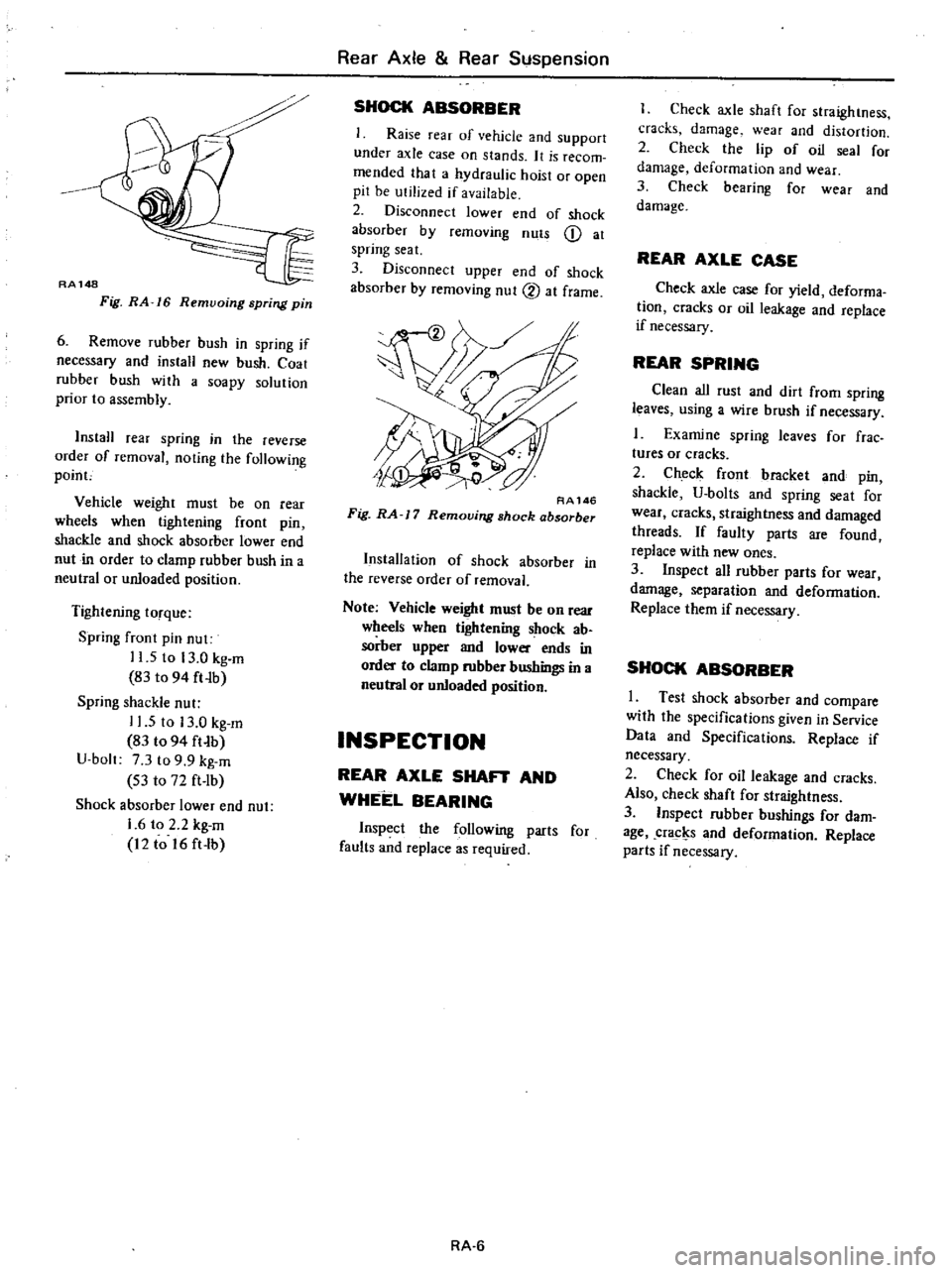
RA148
Fig
RA
16
Remvoing
spring
pin
6
Remove
rubber
bush
in
spring
if
necessary
and
install
new
bush
Coat
rubber
hush
with
a
soapy
solution
prior
to
assembly
InstaH
rear
spring
in
the
reverse
order
of
removal
noting
the
following
poinc
Vehicle
weight
must
be
on
rear
wheels
when
tightening
front
pin
shackle
and
shock
absorber
lower
end
nut
in
order
to
clamp
rubber
bush
in
a
neutral
or
unloaded
position
Tightening
torque
Spring
fTont
pin
nut
11
5
to
13
0
kg
m
83
to
94
ft
Ib
Spring
shackle
nut
11
5
to
13
0
kg
m
83
t094
ft
b
U
bolt
7
3
to
9
9
kg
m
S3
to
72
ft
lb
Shock
absorber
lower
end
nut
1
6
to
2
2
kg
m
12
to
16
ft
lb
Rear
Axle
Rear
Suspension
SHOCK
ABSORBER
Raise
rear
of
vehicle
and
support
under
axle
case
on
stands
It
is
recom
mended
that
a
hydraulic
hoist
or
open
pit
be
utilized
if
available
2
Disconnect
lower
end
of
shock
absorber
by
removing
nuts
Q
at
spring
seat
3
Disconnect
upper
end
of
shock
absorber
by
removing
nut
2
at
frame
RA146
Fig
RA
J
7
Removing
shock
absorber
Installation
of
shock
absorber
in
the
reverse
order
of
removal
Note
Vehicle
weight
must
be
on
Tear
wheels
when
tigtrtening
shock
ab
sorber
upper
and
lower
ends
in
order
to
clamp
rubber
bushings
in
a
neutral
or
unloaded
position
INSPECTION
REAR
AXLE
SHAFT
AND
WHEEL
BEARING
Inspect
the
following
parts
for
faults
and
replace
as
required
RA
6
I
Check
axle
shaft
for
straightness
cracks
damage
wear
and
distortion
2
Check
the
lip
of
oil
seal
for
damage
deformation
and
wear
3
Check
bearing
for
wear
and
damage
REAR
AXLE
CASE
Check
axle
case
for
yield
deforma
tion
cracks
or
oil
leakage
and
replace
if
necessary
REAR
SPRING
Clean
all
rust
and
dirt
from
spring
leaves
using
a
wire
brush
if
necessary
1
Examine
spring
leaves
for
frae
tures
or
cracks
2
Check
front
bracket
and
pin
shackle
U
bolts
and
spring
seat
for
wear
cracks
straightness
and
damaged
threads
If
faulty
parts
are
found
replace
with
new
ones
3
Inspect
all
rubber
parts
for
wear
damage
separation
and
deformation
Replace
them
if
necessary
SHOCK
ABSORBER
I
Test
shock
absorber
and
compare
with
the
specifications
given
in
Service
Data
and
Specifications
Replace
if
necessary
2
Check
for
oil
leakage
and
cracks
Also
check
shaft
for
straightness
3
Inspect
rubber
bushings
for
dam
age
cracl
s
and
deformation
Replace
parts
if
necessary
Page 373 of 537
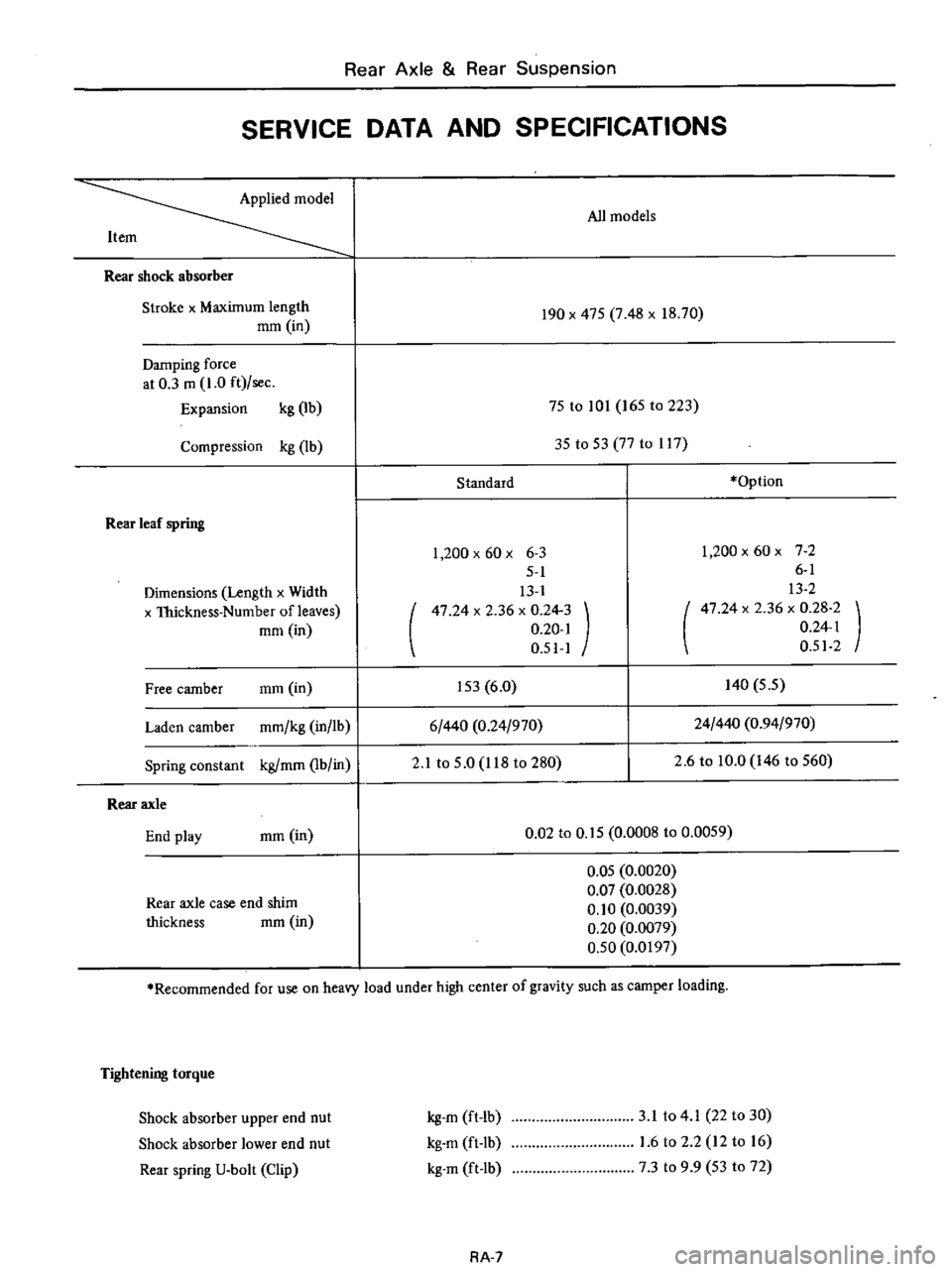
Rear
Axle
Rear
Suspension
SERVICE
DATA
AND
SPECIFICATIONS
Applied
model
All
models
Item
Rear
shock
absorber
Stroke
x
Maximum
length
mOl
in
190
x
47S
7
48
x
18
70
Damping
force
at
0
3
m
1
0
ft
sec
Expansion
kg
lb
75
to
101
165
to
223
Compression
kg
lb
3S
to
S3
77
to
1l7
Standard
Option
Rear
leaf
spring
Dimensions
Length
x
Width
x
Thickness
Number
of
leaves
mOl
in
1
200
x
60
x
6
3
5
1
13
1
47
24
x
2
36
x
0
24
3
0
20
1
0
51
1
1
200x60x
72
6
1
13
2
47
24
x
2
36
x
0
28
2
0
24
1
0
512
Free
camber
mOl
in
IS3
6
0
140
S
5
Laden
camber
mmlkg
in
lb
6
440
0
24
970
24
440
0
94
970
Spring
constant
kg
mOl
lb
in
2
1
to
S
O
118
to
280
2
6
to
10
0
146
to
S60
Rear
axle
End
play
mOl
in
0
02
to
O
IS
0
0008
to
0
0059
Rear
axle
case
end
shim
thickness
mm
in
O
OS
0
0020
0
07
0
0028
0
10
0
0039
0
20
0
0079
0
50
0
0197
Recommended
for
use
on
heavy
load
under
high
center
of
gravity
such
as
camper
loading
Tightening
torque
Shock
absorber
upper
end
nut
Shock
absorber
lower
end
nut
Rear
spring
U
bolt
Clip
kg
m
ft
lb
kg
m
ft
Ib
kg
m
ft
lb
3
1
to
4
1
22
to
30
1
6
to
2
2
12
to
16
7
3
to
9
9
53
to
72
RA
7
Page 374 of 537
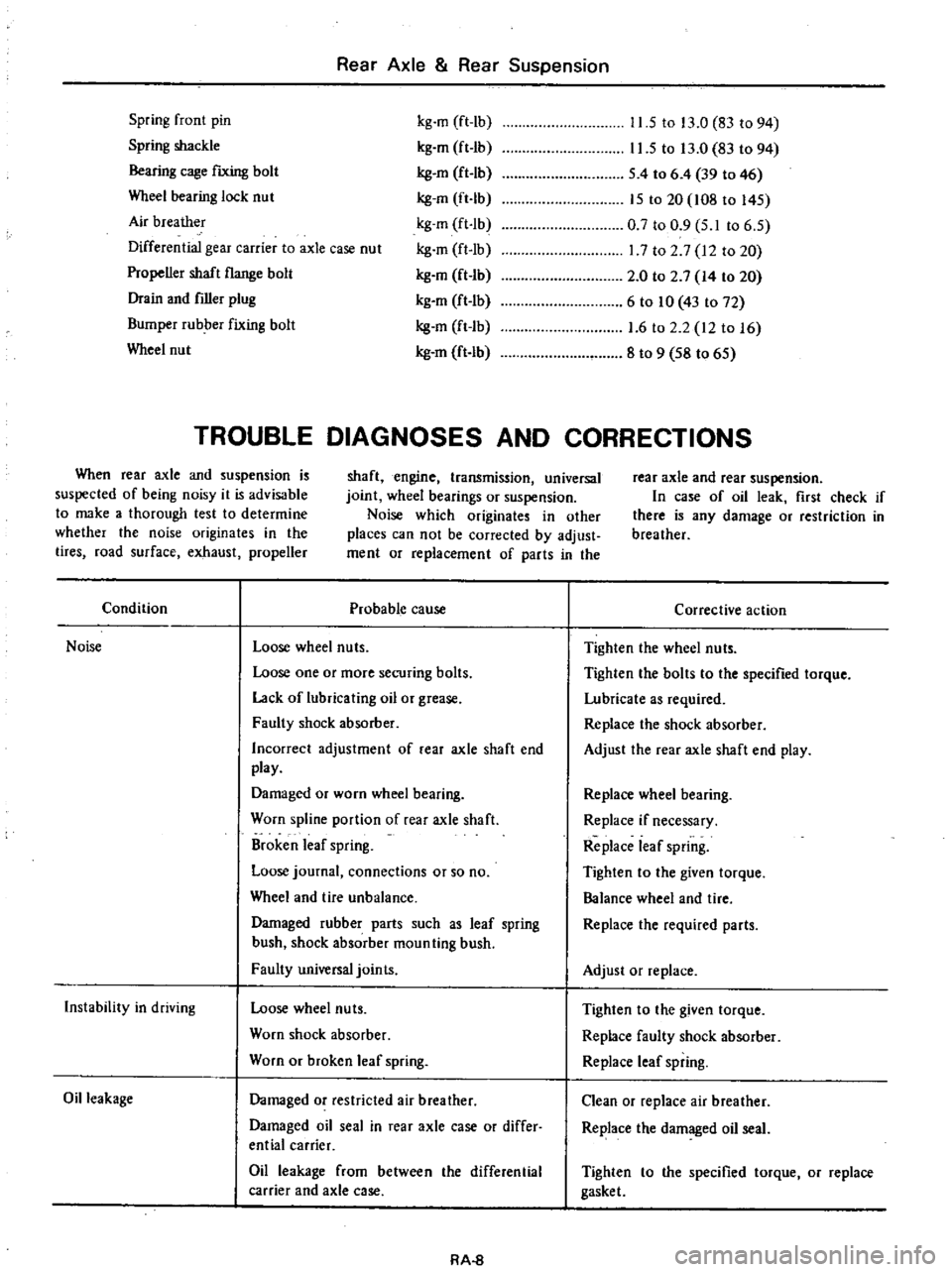
Rear
Axle
Rear
Suspension
Spring
front
pin
Spring
shackle
Bearing
cage
fIXing
bolt
Wheel
bearing
lock
nut
Air
breather
Differential
gear
carrier
to
axle
case
nut
Propeller
shaft
flange
bolt
Drain
and
filler
plug
Bumper
rubber
fixing
bolt
Wheel
nut
kg
m
ft
lb
kg
m
ft
Ib
kg
en
ft
lb
kg
m
ft
Ib
kg
m
ft
Ib
kg
m
ft
Ib
kg
en
ft
Ib
kg
m
ft
Ib
kg
m
ft
Ib
kg
m
ft
lb
11
5
to
13
0
83
to
94
11
5
to
13
0
83
to
94
S
4
to
6
4
39
to
46
IS
to
20
108
to
l4S
0
7
to
0
9
S
I
to
6
S
17
to
2
7
12
to
20
2
0
to
2
7
14
to
20
6
to
10
43
to
72
1
6
to
2
2
12
to
16
8
to
9
S8
to
6S
TROUBLE
DIAGNOSES
AND
CORRECTIONS
When
rear
axle
and
suspension
is
suspected
of
being
noisy
it
is
advisable
to
make
a
thorough
test
to
determine
whether
the
noise
originates
in
the
tires
road
surface
exhaust
propeller
shaft
engine
transmission
universal
joint
wheel
bearings
or
suspension
Noise
which
originates
in
other
places
can
not
be
corrected
by
adjust
ment
or
replacement
of
parts
in
the
rear
axle
and
rear
suspension
In
case
of
oil
leak
first
check
if
there
is
any
damage
or
restriction
in
breather
Condition
Probable
cause
Noise
Loose
wheel
nuts
Loose
one
or
more
securing
bolts
Lack
of
lubricating
oil
or
grease
Faulty
shock
absorber
Incorrect
adjustment
of
rear
axle
shaft
end
play
Damaged
or
worn
wheel
bearing
Worn
spline
portion
of
rear
axle
shaft
Broken
leaf
spring
Loose
journal
connections
or
so
no
Wheel
and
tire
unbalance
Damaged
rubber
parts
such
as
leaf
spring
bush
shock
absorber
moun
ting
bush
Faulty
universal
joints
Instability
in
driving
Loose
wheel
nuts
Worn
shock
absorber
Worn
or
broken
leaf
spring
Oil
leakage
Damaged
or
restricted
air
breather
Damaged
oil
seal
in
rear
axle
case
or
differ
ential
carrier
Oil
leakage
from
between
the
differential
carrier
and
axle
case
RA
8
Corrective
action
Tighten
the
wheel
nuts
Tighten
the
bolts
to
the
specified
torque
Lubricate
as
required
Replace
the
shock
absorber
Adjust
the
rear
axle
shaft
end
play
Replace
wheel
bearing
Replace
if
necessary
Replace
leaf
spring
Tighten
to
the
given
torque
Balance
wheel
and
tire
Replace
the
required
parts
Adjust
or
replace
Tighten
to
the
given
torque
Replace
faulty
shock
absorber
Replace
leaf
spring
Clean
or
replace
air
breather
Replace
the
damaged
oil
seal
Tighten
to
the
specified
torque
or
replace
gasket
Page 375 of 537

Rear
Axle
Rear
Suspension
SPECIAL
SERVICE
TOOLS
Unit
mOl
in
For
use
on
Reference
page
or
Figure
No
No
Tool
number
tool
name
Description
Rear
axle
stand
This
tool
is
used
to
remove
rear
axle
shaft
Use
with
sliding
hammer
ST36230000
All
Fig
RA
S
models
KV40101000
SE402
2
ST36230000
This
tool
is
used
to
remove
rear
axle
shaft
All
Fig
RA
S
Sliding
hammer
Use
with
rear
axle
stand
KV40101000
models
SEll1
3
ST38020000
This
tool
is
used
to
loosen
and
tighten
rear
axle
bearing
lock
nut
620
Fig
RA
7
Bearing
lock
nu
t
wrench
SE238
4
HT72480000
This
tool
is
used
to
drive
out
rear
axle
shaft
bearing
All
rigid
Fig
RA
8
axle
car
models
Rear
axle
shaft
bearing
puller
parts
Iools
are
used
for
other
rear
axle
Iype
SE382
RA
9
Page 376 of 537

DATSUN
PICK
UP
MODEL
620
SERIES
l
4ISSAN
I
NISSAN
MOTOR
CO
LTD
TOKYO
JAPAN
SECTION
BR
BRAKE
SYSTEM
GENERAL
DESCRIPTIDN
BR
2
ADJUSTMENT
BR
2
SERVICE
BRAKE
BR
4
HAND
BRAKE
BR
18
SERVICE
DATA
AND
BR
2D
SPECIFICATlDNS
TROUBLE
DIAGNDSES
BR
22
AND
CORRECTIONS
SPECIAL
SERVICE
TOOLS
BR
25
Page 377 of 537
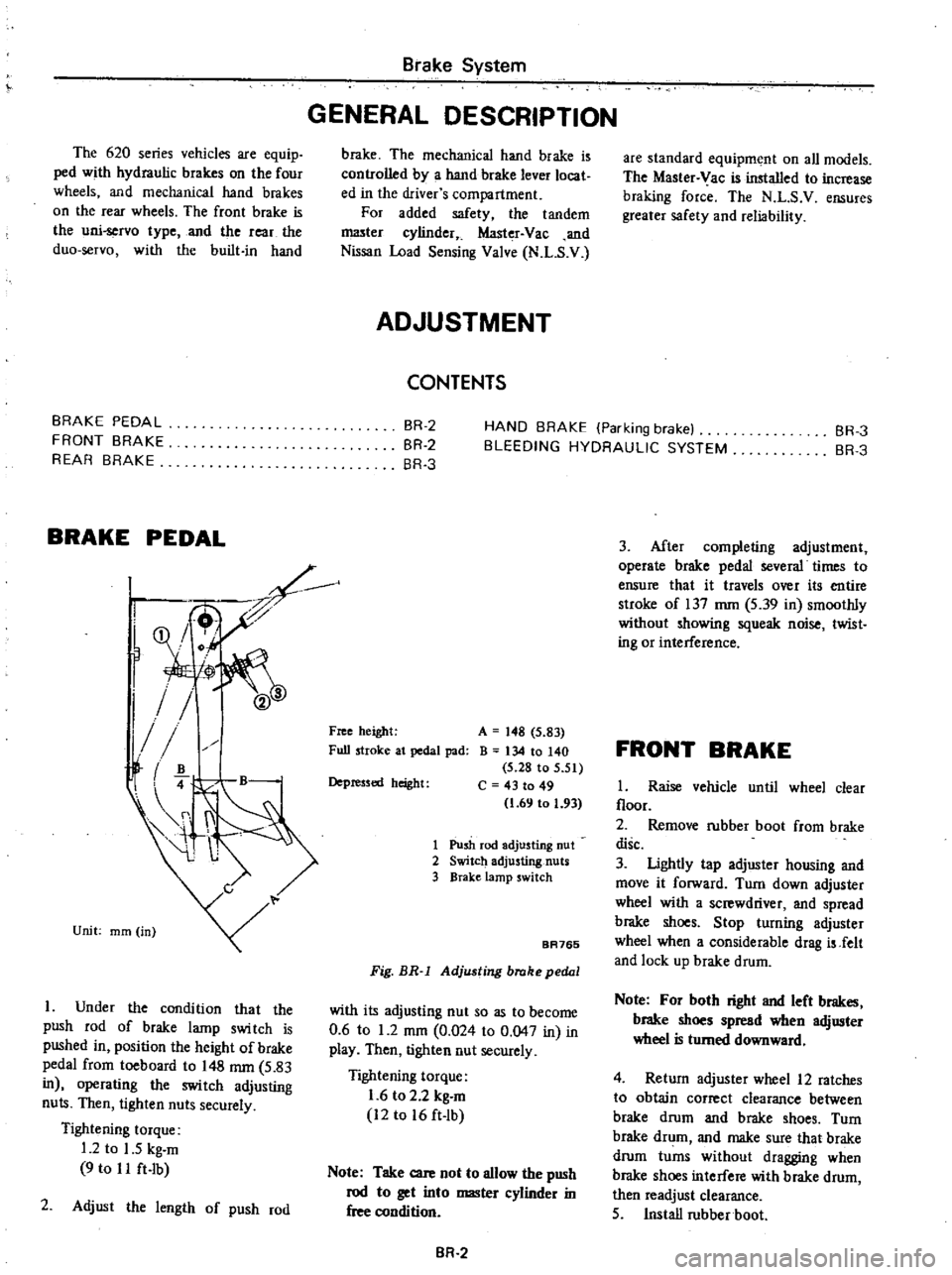
The
620
series
vehicles
are
equip
ped
with
hydraulic
brakes
on
the
four
wheels
and
mechanical
hand
brakes
on
the
rear
wheels
The
front
brake
is
the
uni
servo
type
and
the
rear
the
duo
servo
with
the
built
in
hand
BRAKE
PEDAL
FRONT
BRAKE
REAR
BRAKE
BRAKE
PEDAL
Qi
f
l
II
t
Unit
mm
in
I
Under
the
condition
that
the
push
rod
of
brake
lamp
swi
tch
is
pushed
in
position
the
height
of
brake
pedal
from
toeboard
to
148
mm
5
83
in
operating
the
switch
adjusting
nuts
Then
tighten
nuts
securely
Tightening
torque
1
2
to
1
5
kg
m
9
to
I
I
ft
Ib
2
Adjust
the
length
of
push
rod
Brake
System
GENERAL
DESCRIPTION
brake
The
mechanical
hand
brake
is
controlled
by
a
hand
brake
lever
locat
ed
in
the
driver
s
compartment
For
added
safety
the
tandem
I
1lI3ter
cylinder
Master
Vac
and
Nissan
Load
Sensing
Valve
N
L
S
V
ADJUSTMENT
CONTENTS
are
standard
equipment
on
all
models
The
Master
Vac
is
installed
to
increase
braking
force
The
N
L
S
V
ensures
greater
safety
and
reliability
BR
2
BR
2
BR
3
HAND
BRAKE
Parking
brake
BLEEDING
HYDRAULIC
SYSTEM
BR
3
BR
3
Free
height
Full
stroke
at
pedal
pad
A
148
5
83
B
134
10
140
5
28
to
5
51
C
43
to
49
1
69
to
1
93
Depressed
height
1
Push
rod
adjusting
nut
2
Switch
adjusting
nuts
3
BraKe
lamp
switch
BA765
Fig
BR
l
Adjusting
brake
pedal
with
its
adjusting
nut
so
as
to
become
0
6
to
1
2
mOl
0
024
to
0
047
in
in
play
Then
tigh1en
nut
securely
Tightening
torque
1
6
to
2
2
kg
m
12
to
16
ft
lb
Note
Take
care
not
to
allow
the
push
rod
to
get
into
master
cylinder
in
free
condition
BR
2
3
After
completing
adjustment
operate
brake
pedal
several
times
to
ensure
that
it
travels
over
its
entire
stroke
of
137
mm
5
39
in
smoothly
without
showing
squeak
noise
twist
ing
or
interference
FRONT
BRAKE
1
Raise
vehicle
until
wheel
clear
floor
2
Remove
rubber
boot
from
brake
disc
3
Ughtly
tap
adjuster
housing
and
move
it
forward
Turn
down
adjuster
wheel
with
a
screwdriver
and
spread
brake
shoes
Stop
turning
adjuster
wheel
when
a
considerable
drag
is
Jelt
and
lock
up
brake
drum
Note
For
both
right
and
left
brakes
brake
shoes
spread
when
adjuster
wheel
is
turned
downward
4
Return
adjuster
wheel
12
ratches
to
obtain
correct
clearance
between
brake
drum
and
brake
shoes
Turn
brake
drum
and
make
sure
that
brake
drum
turns
without
dragging
when
brake
shoes
interfere
with
brake
drum
then
readjust
clearance
5
Install
rubber
boot
Page 378 of 537
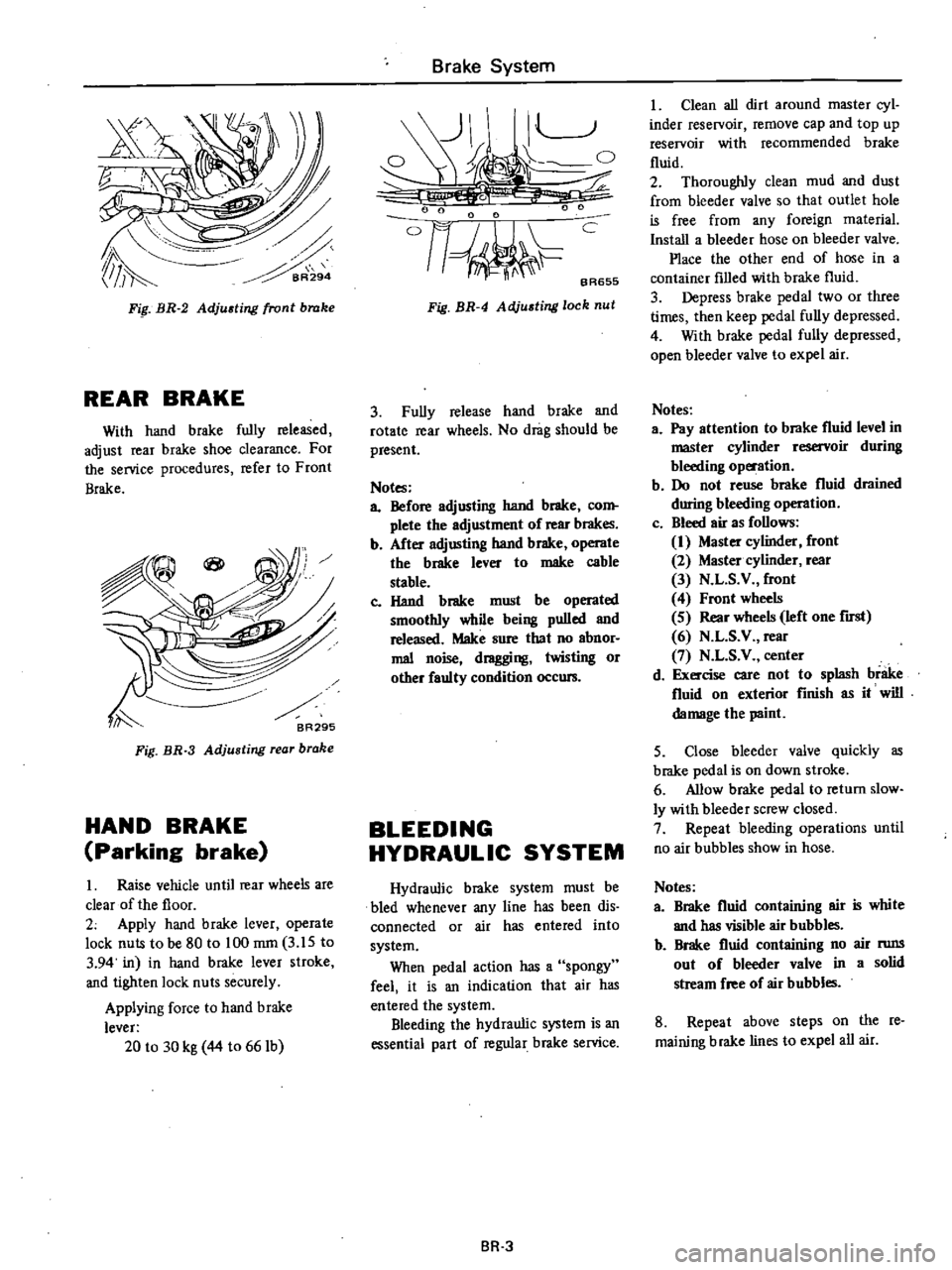
Fip
BR
2
Adjusting
front
brake
REAR
BRAKE
With
hand
brake
fully
released
adjust
rear
brake
shoe
clearance
For
the
service
procedures
refer
to
Front
Brake
Fig
BR
3
Adjusting
rear
brake
HAND
BRAKE
Parking
brake
I
Raise
vehicle
until
rear
wheels
are
clear
of
the
floor
2
Apply
hand
brake
lever
operate
lock
nuts
to
be
80
to
100
mrn
3
lS
to
3
94
in
in
hand
brake
lever
stroke
and
tighten
lock
nuts
securely
Applying
force
to
hand
brake
lever
20
to
30
kg
44
to
661b
Brake
System
1
t
0
t
6
0
I
o
nJ
c
BA655
Fig
BR
4
Adjusting
lock
nut
3
Fully
release
hand
brake
and
rotate
rear
wheels
No
drag
should
be
present
Notes
a
Before
adjusting
hand
brake
com
plete
the
adjustment
of
rear
brakes
b
After
adjusting
hand
brake
operate
the
brake
lever
to
make
cable
stable
c
Hand
brake
must
be
operated
smoothly
while
being
pulled
and
released
Make
sure
that
no
abnor
mal
noise
dragging
twisting
or
other
faulty
condition
occurs
BLEEDING
HYDRAUL
Ie
SYSTEM
Hydraulic
brake
system
must
be
bled
whenever
any
line
has
been
dis
connected
or
air
has
entered
into
system
When
pedal
action
has
a
spongy
feel
it
is
an
indication
that
air
has
entered
the
system
Bleeding
the
hydraulic
system
is
an
essential
part
of
regular
brake
service
BR
3
I
Clean
all
dirt
around
master
cyl
inder
reservoir
I
remove
cap
and
top
up
reservoir
with
recommended
brake
fluid
2
Thoroughly
clean
mud
and
dust
from
bleeder
valve
so
that
outlet
hole
is
free
from
any
foreign
material
Install
a
bleeder
hose
on
bleeder
valve
Place
the
other
end
of
hose
in
a
container
filled
with
brake
fluid
3
Depress
brake
pedal
two
or
three
times
then
keep
pedal
fully
depressed
4
With
brake
pedal
fully
depressed
open
bleeder
valve
to
expel
air
Notes
a
Pay
attention
to
brake
fluid
level
in
master
cylinder
reservoir
during
bleeding
operation
b
Do
not
reuse
brake
fluid
drained
during
bleeding
operation
c
Bleed
air
as
follows
1
Master
cylinder
front
2
Master
cylinder
rear
3
N
L
S
V
front
4
Front
wheels
S
Rear
wheels
left
one
first
6
N
L
S
V
rear
7
N
L
S
V
center
d
Exercise
care
not
to
splash
brake
fluid
on
exterior
finish
as
it
will
damage
the
paint
5
Close
bleeder
valve
quickly
as
brake
pedal
is
on
down
stroke
6
Allow
brake
pedal
to
return
slow
ly
with
bleeder
screw
closed
7
Repeat
bleeding
operations
until
no
air
bubbles
show
in
hose
Notes
a
Brake
fluid
containing
air
is
white
and
has
visible
air
bubbles
b
Brake
fluid
containing
no
air
nms
out
of
bleeder
valve
in
a
solid
stream
free
of
air
bubbles
8
Repeat
above
steps
on
the
re
maining
brake
lines
to
expel
all
air
Page 379 of 537
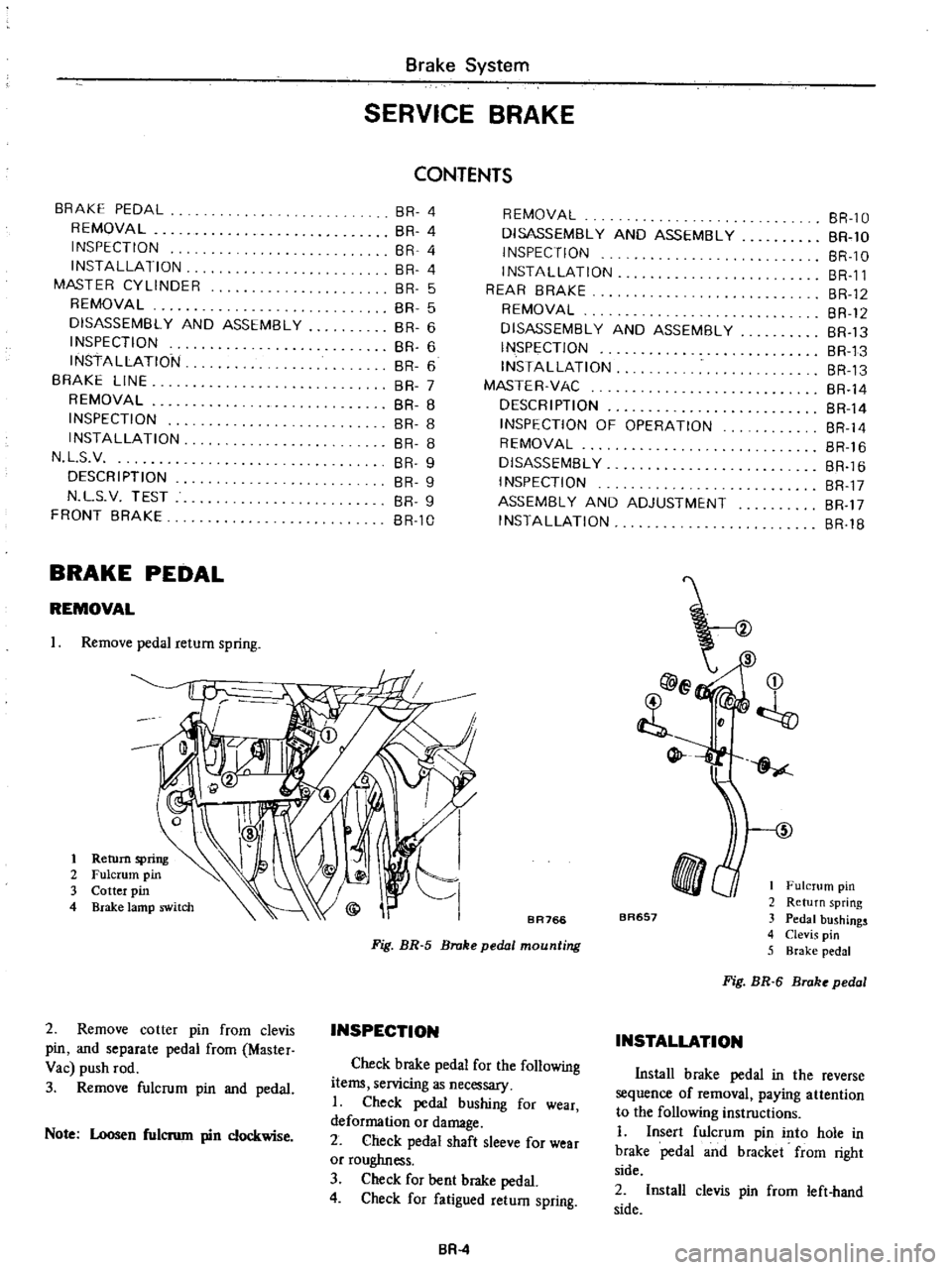
Brake
System
SERVICE
BRAKE
CONTENTS
BRAKE
PEDAL
REMOVAL
INSPECTION
INSTAllATION
MASTER
CYLINDER
REMOVAL
DISASSEMBl
Y
AND
ASSEMBLY
INSPECTION
INSTAllATION
BRAKE
LINE
REMOVAL
INSPECTION
INSTAllATION
N
L
S
V
DESCRIPTION
N
L
S
V
TEST
FRONT
BRAKE
BR
4
BR
4
BR
4
BR
4
BR
5
BR
5
BR
6
BR
6
BR
5
BR
7
BR
B
BR
B
BR
B
BR
9
BR
9
BR
9
BR
lO
BRAKE
PEDAL
REMOVAL
Remove
pedal
return
spring
I
2
3
4
REMOVAL
DISASSEMBl
Y
AND
ASSEMBLY
INSPECTION
INSTAllATION
REAR
BRAKE
REMOVAL
DISASSEMBLY
AND
ASSEMBLY
INSPECTION
INSTAllATION
MASTER
VAC
DESCRIPTION
INSPECTION
OF
OPERATION
REMOVAL
DISASSEMBLY
INSPECTION
ASSEMBl
Y
AND
ADJUSTMENT
INSTAllATION
BR
lO
BR
1O
BR
lO
BR
ll
BR
12
BR
12
BR
13
BR
13
BR
13
BR
14
BR
14
BR
14
BR
16
BR
16
BR
17
BR
17
BR
IB
b
i
t
I
Fulcrum
pin
2
Return
spring
3
Pedal
bushings
4
Clevis
pin
5
Brake
pedal
5
BR766
BR657
Fig
BR
5
Broke
pedal
mounting
2
Remove
cotter
pin
from
clevis
pin
and
separate
pedal
from
Master
Vac
push
rod
3
Remove
fulcrum
pin
and
pedal
INSPECTION
Fig
BR
6
Broke
pedal
INSTALLATION
Check
brake
pedal
for
the
following
items
servicing
as
necessary
I
Check
pedal
bushing
for
wear
deformation
or
damage
2
Check
pedal
shaft
sleeve
for
wear
or
roughness
3
Check
for
bent
brake
pedal
4
Check
for
fatigued
return
spring
Note
Loosen
fulcnun
pin
clockwise
Install
b
rake
pedal
in
the
reverse
sequence
of
removal
paying
attention
to
the
following
instructions
1
Insert
fulcrum
pin
into
hole
in
brake
pedal
and
bracket
from
right
side
2
Install
clevis
pin
from
left
hand
side
BA
4
Page 380 of 537
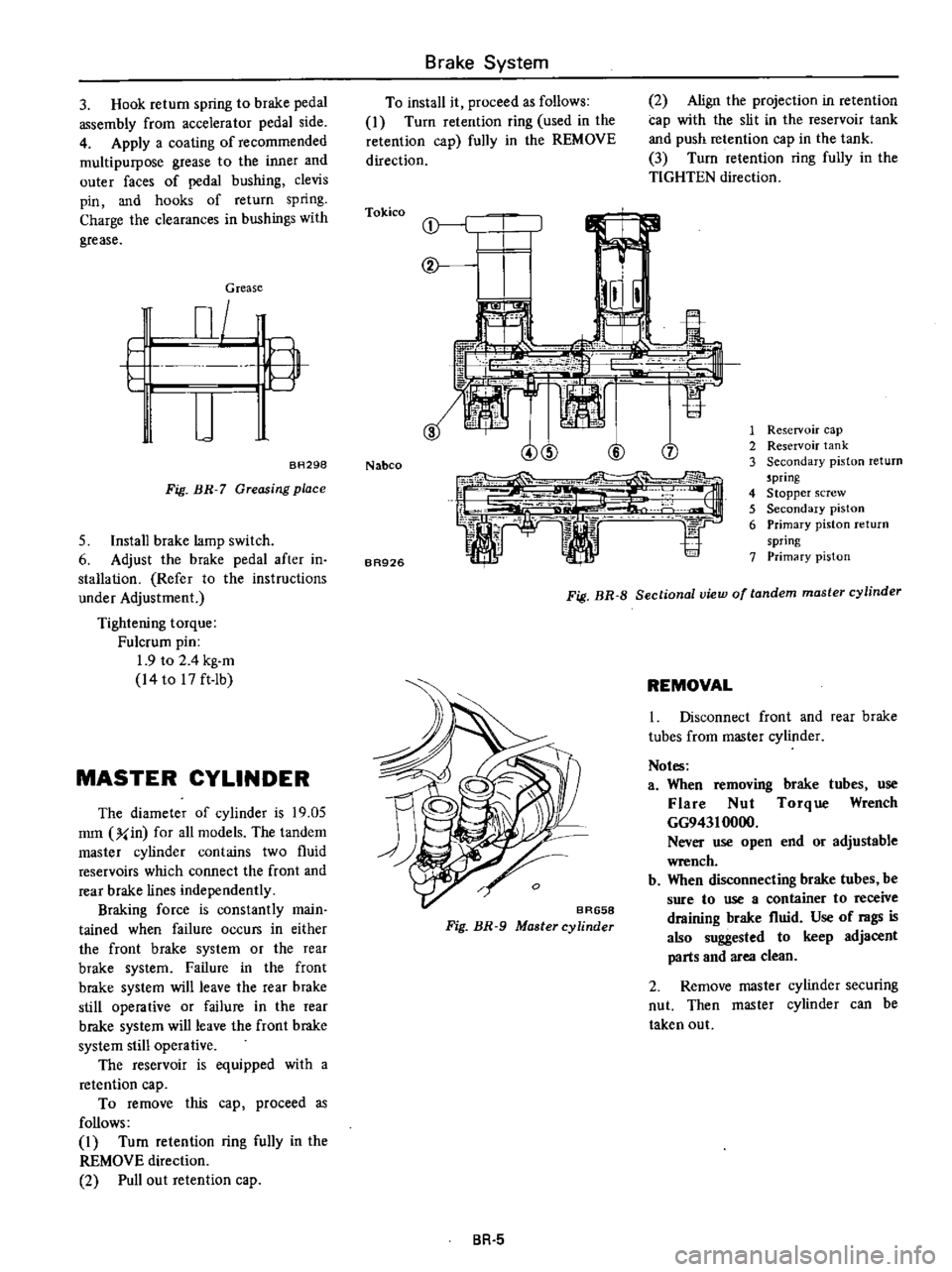
3
Hook
return
spring
to
brake
pedal
assembly
from
accelerator
pedal
side
4
Apply
a
coating
of
recommended
multipurpose
grease
to
the
inner
and
outer
faces
of
pedal
bushing
clevis
pin
and
hooks
of
return
spring
Charge
the
clearances
in
bushings
with
grease
Grease
m
n
L
g
U
BR298
Fig
BH
7
Greasing
place
5
lnstali
brake
lamp
switch
6
Adjust
the
brake
pedal
after
in
stallation
Refer
to
the
instructions
under
Adjustment
Tightening
torque
Fulcrum
pin
1
9
to
2
4
kg
m
14to
17ft
ib
MASTER
CYLINDER
The
diameter
of
cylinder
is
19
05
mm
y
in
for
all
models
The
tandem
master
cylinder
contains
two
fluid
reservoirs
which
connect
the
front
and
rear
brake
lines
independently
Braking
force
is
constantly
main
tained
when
failure
occurs
in
either
the
front
brake
system
or
the
rear
brake
system
Failure
in
the
front
brake
system
will
leave
the
rear
brake
still
operative
or
failure
in
the
rear
brake
system
will
leave
the
front
brake
system
still
operative
The
reservoir
is
eq
ui
pped
with
a
retention
cap
To
remove
this
cap
proceed
as
follows
I
Tum
retention
ring
fully
in
the
REMOVE
direction
2
Pull
out
retention
cap
Brake
System
To
install
it
proceed
as
follows
I
Turn
retention
ring
used
in
the
retention
cap
fully
in
the
REMOVE
direction
Tokico
@
1tr
I
I
I
j
1
Nabco
BR926
2
Align
the
projection
in
retention
cap
with
the
slit
in
the
reservoir
tank
and
push
retention
cap
in
the
tank
3
Turn
retention
ring
fully
in
the
TIGHTEN
direction
00
CD
1
Reservoir
cap
2
Reservoir
tank
3
Secondary
piston
return
5pring
4
Stopper
screw
5
Secondary
piston
6
Primary
piston
return
spring
7
Primary
piston
Fig
BR
B
Sectional
view
of
tandem
master
cylinder
o
BR658
Fig
BR
9
Master
cylinder
BR
5
REMOVAL
1
Disconnect
front
and
rear
brake
tubes
from
master
cylinder
Notes
a
When
removing
brake
tubes
use
Flare
Nut
Torque
Wrench
GG94310000
Never
use
open
end
or
adjustable
wrench
b
When
disconnecting
brake
tubes
be
sure
to
use
a
container
to
receive
draining
brake
flnid
Use
of
rags
is
also
suggested
to
keep
adjacent
parts
and
area
clean
2
Remove
master
cylinder
securing
nut
Then
master
cylinder
can
be
taken
out